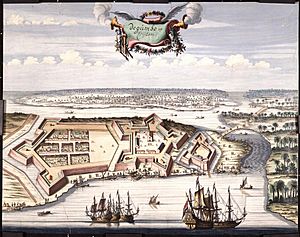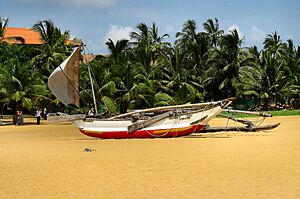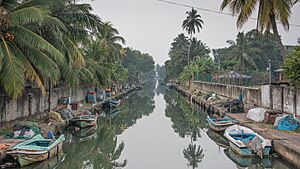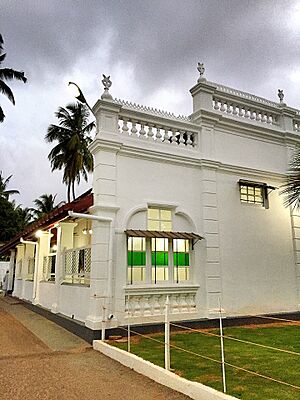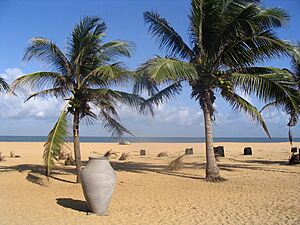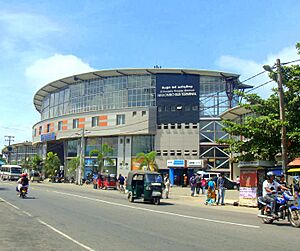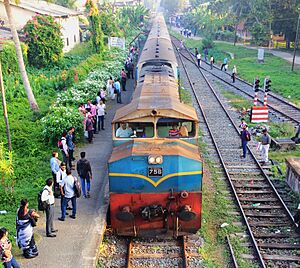Negombo facts for kids
Quick facts for kids
Negombo
|
|
|---|---|
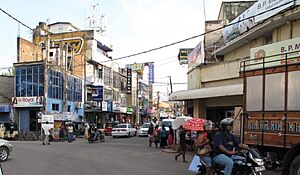 |
|
| Nickname(s):
Punchi Romaya (Little Rome), Meepura (City of Bees)
|
|
| Motto(s):
"Unity Peace and Concord" (සමගිය සාමය සහ.එකඟතාවය)
|
|
| Country | Sri Lanka |
| Province | Western Province |
| District | Gampaha |
| Division | Negombo |
| Government | |
| • Type | Municipal Council |
| • Body | Negombo Municipal Council |
| Area | |
| • Urban | 30 km2 (11.58 sq mi) |
| • Metro | 34 km2 (13.12 sq mi) |
| Elevation | 2 m (7 ft) |
| Population | |
| • Ethnic groups | Sinhalese Sri Lankan Tamils Sri Lankan Moors Sri Lankan Malays Burghers and Sri Lankan Chinese |
| Demonym(s) | Negombians |
| Time zone | UTC+5:30 (Sri Lanka Standard Time Zone) |
| Postal code |
11500
|
| Area code(s) | 031 |
Negombo (Sinhala: මීගමුව, romanized: Mīgamuva, Tamil: நீர்கொழும்பு, romanized: Nīrkoḻumpu) is a big city in Sri Lanka. It is on the west coast, right where the Negombo Lagoon meets the sea. Negombo is in the Western Province. It is about 38 km from Colombo if you take the Colombo–Katunayake Expressway. It is also the closest major city to the Bandaranaike International Airport, only about 9 km away.
Negombo is an important business center in Sri Lanka. It is also the main administrative hub for the Negombo Division. About 142,136 people live within the Negombo area.
The city is famous for its long sandy beaches and its old fishing industry. Many people in Negombo speak both Sinhala and Tamil. Most of the people here are Roman Catholic.
Contents
What's in a Name?
The name "Negombo" comes from the Portuguese way of saying its Tamil name, Neerkolombu.
The Sinhala name, Migamuva, comes from an old Tamil term, mīgamaṉ paṭṭiṉam. This term relates to naval captains. The local Karava people have a long history with the navy and fishing. Later, the name also became known as "Village of the honeycomb". This comes from a legend in the Rajaveliya book. It says that King Kavantissa's army found bee honey in a boat near the sea. This honey was for Viharamahadevi, who was pregnant with Prince Dutugamunu. Because of this, the place was called "Mee-Gomuwa".
A Look Back in Time
The calm waters of the Negombo Lagoon were a safe place for ships. This made Negombo one of the main ports in Sri Lanka. Along with places like Kalpitiya and Colombo, it was used by Sri Lankan kingdoms for trading with other countries.
Before European Rule
Before the Portuguese arrived in the 1500s, the Negombo area was ruled by the Sinhala kings from Sri Jayawardanapura Kotte. People spoke a local type of Sinhala.
Negombo was also a safe harbor for Arabic ships. The descendants of these traders are today known as the Sri Lankan Moors. Negombo was a busy trading port, especially known for growing cinnamon. The kings of Sri Lanka first controlled the cinnamon trade, and later the Sri Lankan Moors managed it.
Portuguese Influence
The Portuguese landed in the early 1500s. They took control of the area from the Sinhala kings. The Portuguese built a fort in Negombo. They also took over the cinnamon trade to the West. During their time, many Karava people, who were mainly Buddhist and Hindu, became Catholic. Because so many people became Catholic, Negombo is sometimes called 'Little Rome' today. About two-thirds of its people are Catholic.
The Portuguese changed how cinnamon was grown and managed. They kept control of this trade for over 100 years. But their power started to weaken in the 1630s. This was when the war between the Portuguese and the Kingdom of Kandy became a stalemate. The King of Kandy then asked the Dutch for help.
Dutch Rule
The Dutch took Negombo from the Portuguese in 1646. They agreed to a ten-year peace with Portugal. During this time, the King of Kandy tried to cause trouble between the two groups. He would pass through one group's land to attack the other. Once, he captured the Negombo fort. He even sent the head of the Dutch commander, Adrian Vander Stell, to his people in Galle. The Dutch got Negombo back through talks, but fighting continued. The King often stopped the cinnamon trade to bother the Dutch.
Throughout the 1700s, there was more demand for Ceylon cinnamon than could be supplied. Its quality also seemed to get worse. Other problems, like ongoing conflict with the Kandyan Kingdom and new cinnamon coming from China, caused the amount of cinnamon exported to drop by 40% between 1785 and 1791. This happened even though people tried to clear land around Negombo to grow more cinnamon.
You can still see signs of Dutch rule today. There is the Negombo fort, built in 1672. There are also other Dutch buildings, including churches. A large canal system, built by the Dutch, runs for 120 km. It goes from Colombo in the south, through Negombo, to Puttalam in the north.
British Rule
By 1796, when British commander Colonel Stuart took over the cinnamon trade, it was already declining. Bad decisions by Frederick North, the first Governor of British Ceylon, made things worse. By the 1830s, people were more interested in other businesses.
After the British took over the Kingdom of Kandy in 1815, Negombo was no longer as important as a military base for Colombo. However, its business influence continued to grow. The Negombo fishery was key to the seafood trade in Ceylon. Many fishermen came each year, and their earnings helped the small, thriving town. In 1907, Negombo was connected to a big railway project. This project linked the island under British control. It also helped plantations grow coconuts, tea, and coffee.
What is Negombo Like?
Negombo is about 2 meters above sea level. It has a mix of land and water. The Hamilton Canal flows through the middle of the city. The Negombo Lagoon is one of Negombo's most beautiful spots. It has over 190 types of wildlife and many birds in its mangrove forests. The Maha Oya river forms the city's northern edge and flows into the Indian Ocean.
Weather in Negombo
Negombo has a tropical rainforest climate. This means it gets a lot of rain. The rain mostly comes from the Southwestern monsoons from May to August and October to January. In other months, there is less rain, but some still falls. The city gets about 2,400 mm of rain each year. The average temperature is between 24°C and 30°C. It is very humid from February to April.
| Climate data for Negombo, Sri Lanka | |||||||||||||
|---|---|---|---|---|---|---|---|---|---|---|---|---|---|
| Month | Jan | Feb | Mar | Apr | May | Jun | Jul | Aug | Sep | Oct | Nov | Dec | Year |
| Mean daily maximum °C (°F) | 30 (86) |
31 (88) |
31 (88) |
31 (88) |
31 (88) |
29 (84) |
29 (84) |
29 (84) |
29 (84) |
29 (84) |
29 (84) |
29 (84) |
30 (86) |
| Mean daily minimum °C (°F) | 22 (72) |
22 (72) |
23 (73) |
24 (75) |
26 (79) |
25 (77) |
25 (77) |
25 (77) |
25 (77) |
24 (75) |
23 (73) |
22 (72) |
24 (75) |
| Average precipitation mm (inches) | 89 (3.5) |
69 (2.7) |
147 (5.8) |
231 (9.1) |
371 (14.6) |
224 (8.8) |
135 (5.3) |
109 (4.3) |
160 (6.3) |
348 (13.7) |
315 (12.4) |
147 (5.8) |
2,345 (92.3) |
Areas in Negombo
- Athgala
- Basiyawatte
- Bolawalana
- Dalupotha
- Daluwakotuwa
- Dungalpitiya
- Duwa
- Duwane
- Ethukala
- Kadolkale
- Kamachchodai
- Kandawala
- Kapumgoda
- Kattuwa
- Katunayake
- Katuwapitiya
- Kimbulapitiya
- Kochchikade
- Kurana
- Kudapadu
- Mahahunupitiya, also known as Maha Hunupitiya, a predominantly Catholic neighborhood
- Munnakkarai
- Muruthena
- Nugawala
- Palangathura
- Pallansena
- Periyamulla
- Pitipana
- Poruthota
- Raheemanabad
- Sarakkuwa
- Sellakanda
- Thillanduwa
- Thaladuwa
- Thalahena
- Udyar Thoppu
- Wella veediya
- Welihena
- Kadirana
- Akkarapanaha
- Thimbirigaskatuwa
- Katana
Negombo Lagoon: A Natural Treasure
The Negombo Lagoon is a large body of water that is partly closed off from the sea. It has many natural resources. Several small rivers and the Hamilton Canal (also called the Dutch canal) flow into the lagoon. It connects to the Indian Ocean through a narrow channel near Negombo. The lagoon and its marshy areas also help local farming and forestry. It has large mangrove swamps, which attract many different water birds. The lagoon is home to many kinds of plants, animals, and birds. It is a popular spot for both locals and tourists who enjoy sightseeing and boat tours.
Fishermen who work on the Negombo lagoon live in simple villages made of thatch palm along the water's edge. They use their traditional knowledge of the seasons to make a living. They use outrigger canoes carved from tree trunks and nylon nets to catch fish from September to April. Their boats come in two types: oruvas (a kind of sailing canoe) and paruvas (a large, human-powered catamaran with dividers). In recent years, these villagers have also earned money by collecting 'toddy'. This is palm sap used to make arrack.
Who Lives in Negombo?
Based on 2011 numbers, about 6.3% of the people in the Gampaha district live in Negombo city. About 11.6% of the district's population lives in the larger Negombo area. It is a city with many different ethnic groups and cultures. Most people in Negombo are from the Sinhalese group. There are also Tamil and Muslim people living in the city. A long-standing Chinese community also calls Negombo home.
| 2012 Population | Percentage | |
|---|---|---|
| Roman Catholic | 92,527 | 65.31% |
| Muslim | 20,308 | 14.33% |
| Buddhist | 15,681 | 11.07% |
| Hindu | 8,290 | 5.85% |
| Other Christian | 4,740 | 3.35% |
| Other | 130 | 0.09% |
| Total | 141,676 | 100.00% |
| 2012 Population | Percentage | |
|---|---|---|
| Sinhalese | 107,155 | 75.63% |
| Sri Lankan Moor | 19,364 | 13.67% |
| Sri Lankan Tamil | 12,590 | 8.89% |
| Indian Tamil | 904 | 0.64% |
| Other | 599 | 0.42% |
| Burgher | 414 | 0.29% |
| Baratha | 281 | 0.20% |
| Malay | 278 | 0.20% |
| Sri Lankan Chetty | 91 | 0.06% |
| Total | 141,676 | 100.00% |
Places of Worship
Negombo is a city where many religions are practiced. Since Europeans first came, Negombo has had a lot of Roman Catholics. There are also Muslims, Buddhists, and Hindus.
Churches in Negombo
Negombo is called "Little Rome" because of its many beautiful Roman Catholic churches. These churches were built during the Portuguese era. Most people in the city are Roman Catholic. Some of the biggest churches are St. Mary's Church, St. Sebastian's Church, Katuwapitiya, and St. Anthony's Church Dalupothal. There are over 25 Roman Catholic churches in Negombo.
There is also a church for the Church of Jesus Christ of Latter-day Saints in Negombo. You can also find Methodist, Baptist, and Anglican churches in the city.
Buddhist Temples (Pansal)
The Agurukaramulla Raja Maha Viharaya (Bodhirajaramaya) is a famous Buddhist temple. Buddhists from all over Sri Lanka visit it every year. Other well-known Buddhist temples in Negombo include Abhayasekararamaya Temple and Sri Sudarshanaramaya.
Hindu Temples (Kovil)
Negombo has many Hindu temples. Some of them are Kali Amman temple, Ganapathi (Pillaiar) Temple, and Muththumari Amman Temple.
Mosques (Masjid)
There are nine main mosques in Negombo. The Kamachchoda Jummah Masjid is one of the oldest mosques in Sri Lanka. Another old mosque is the Udayar Thoppuwa Mosque. It was built in 1846 and is still used today.
What is Negombo's Economy Like?
Negombo is one of the biggest economic centers in Sri Lanka. It is only about 4 to 5 km from the Bandaranaike International Airport and the free trade zone. Negombo also has a small port. This port was used during the times of Portuguese and Dutch rule.
Negombo's economy mainly relies on tourism and its very old fishing industry. But it also produces cinnamon, ceramics, and brass items.
Many big financial companies have offices in Negombo. You can find department stores, large supermarkets, and small shops in the busy streets of Downtown Negombo. International food places are also opening up.
How to Get Around Negombo
The E03 - Airport Expressway opened in 2013. This road connects Colombo to Negombo through the Katunayake Interchange. It makes travel time much shorter, about 20 to 30 minutes. Getting from Negombo to the Katunayake Interchange takes about 5 to 10 minutes.
There are highway bus services from Negombo to Pettah and Maharagama using the Airport Expressway. You can also take buses from Negombo to Galle, Kataragama, and Matara (the southern tip of the country) using the Southern Expressway. Buses also go to Kadawatha, Kottawa, Panadura, and Moratuwa using the Outer Circular Expressway.
The A3 Colombo–Negombo highway goes through Negombo. It then extends to Jaffna and Trincomalee through Anuradhapura. Negombo is also connected by other roads to places like Ja-Ela and Kurunegala. The city has a good road network.
The Negombo Bus Terminal has many services for travelers. Buses connect Negombo to major places like Colombo, Kandy, Kegalle, and Puttalam.
Because Negombo is on the A3 Highway, many bus routes from Colombo to northern Sri Lanka pass through it. These include buses to Jaffna, Anuradhapura, and Mannar.
Negombo has four railway stations: Kurana, Negombo Downtown, Kattuwa, and Kochchikade. Negombo Downtown Station is the main one on the Puttalam railway line. Trains go south to Galle (through Colombo) and north to Puttalam (through Chilaw). The Sri Lanka Railway Department has a fast train between Chilaw and Colombo that stops at Negombo Downtown and Kochchikade Stations.
The Negombo Downtown Station is close to the main Bus Terminal. Negombo is the closest big city to the Bandaranaike International Airport. It is also near the Katunayake Interchange of the Airport Expressway.
Schools in Negombo
Negombo is home to some of the oldest secondary schools in Sri Lanka. Here are some of the main schools:
- Ave Maria Convent
- Maris Stella College
- St. Mary's College, Negombo
- Newstead Girls College
- Harischandra National College
- Loyola College
- Wijayaratnam Hindu Central College
- St Joseph's College (Negombo Branch School of St Joseph's College, Colombo 10)
- St. Peter's College (Negombo Branch School of St Peter's College, Colombo)
- Maris Stella Branch College
- Ave Maria Dominican Convent
- Al-Hilal Muslim Central College
- St. Peter's Maha Vidyalaya
- Vidyalankara Maha Vidyalaya
- St Sebastian's Maha vidyalaya, Sea Street
- St Anne's Maha Vidyalaya- Daluwakotuwa
- St. Anne's Maha Vidyalaya-Kurana
- Nimala Maria Maha Vidyalaya-Bolawalana
- Al-Falah Muslim School
- Vidyaloka Vidyalaya
- Our Lady of Miracle School
- St Joseph's Vidyalaya
- St Mary's Pitipana Maha Vidyalaya
- Kochchikade Maha Vidyalaya
- Gateway College
- St. Thomas Catholic International College
- Leeds International College
- St. Nicholas International College
- NICE International College
- Adventist International School
- OKI International School
- St. Michell's College
- Negombo International College
- Sussex College
- JMC International School
- Negombo South International School
- Wisdom International School
- Sailan International School
- Regent Language International
Negombo also has many places for higher education and private classes. The Ocean University of Sri Lanka Negombo campus offers degrees in Nautical Engineering, Marine Science, and Fisheries. Other institutes include BCI Campus and ESOFT Metro Campus.
Famous People from Negombo
Many notable people have come from Negombo.
During British Rule in Ceylon
- Mudaliyar John de Silva Wijegooneratne Rajapakshe JP (1841–1909)
- Muhammed Thamby Samsudheen Vidane Arachchi (1860–1915), also known as Dheen Arachchi. He was the highest-ranking Muslim official in Negombo's local government from 1896 to 1915. Dheen Junction in Negombo is named after him.
- Gate Mudaliyar A. E. Rajapakse OBE (1866–1937). He was the first chairman of the Negombo Urban Council. Rajapakse Park and Rajapakse Broadway are named after him.
- Samsudheen M. Abdul Raheeman JPUM (1896–1965). He was the first Muslim chairman of the Negombo Urban Council. Raheemanabad in Periyamulla, Negombo, is named after him.
- William Mohotti Munasinghe (1902–1962), an aide to the British Governor and a Mudaliyar of Negombo.
- Mudaliyar Thenahandi David Mendis (1904–1977). He founded the Wijaya Bus Company. Mudaliyar Mendis Mawatha in Negombo is named after him.
During Independent Ceylon
- Thomas Cooray (1901–1988). He was the first Sri Lankan Archbishop of Colombo and the first Sri Lankan Cardinal.
- Alexander Nicholas de Abrew Abeysinge CBE, JPUM (1894–1963). He was elected as the first Mayor of the Negombo Municipal Council in 1950.
- Thenahandi Wijayapala Hector Mendis (1928–2012). He was elected Mayor of Negombo in 1954. He later became a Member of Parliament and served as a Minister. Wijayapala Mendis Road in Negombo is named after him.
During the Republic of Sri Lanka
- Frank Marcus Fernando (1931–2009). He served as the Bishop of the Roman Catholic Diocese of Chilaw.
- Nicholas Fernando (1932–2020). He served as the Archbishop of the Roman Catholic Archdiocese of Colombo.
- Ranjan Ramanayake (born 1963). He was an actor and director before becoming a Member of Parliament. He served as the State Minister of Highways and Road Development.
See also
 In Spanish: Negombo para niños
In Spanish: Negombo para niños



